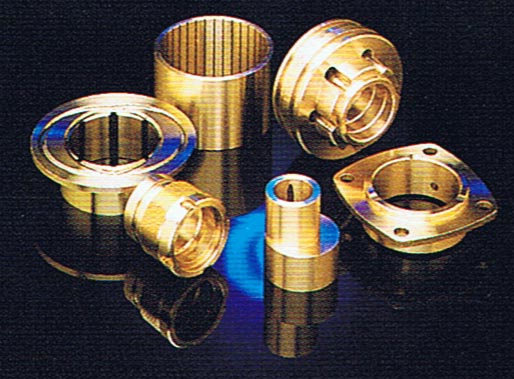Red brass on:
[Wikipedia]
[Google]
[Amazon]
 Gun metal, also known as red brass in the United States, is a type of bronze; an
Gun metal, also known as red brass in the United States, is a type of bronze; an
 Gun metal, also known as red brass in the United States, is a type of bronze; an
Gun metal, also known as red brass in the United States, is a type of bronze; an alloy
An alloy is a mixture of chemical elements of which at least one is a metal. Unlike chemical compounds with metallic bases, an alloy will retain all the properties of a metal in the resulting material, such as electrical conductivity, ductilit ...
of copper
Copper is a chemical element with the symbol Cu (from la, cuprum) and atomic number 29. It is a soft, malleable, and ductile metal with very high thermal and electrical conductivity. A freshly exposed surface of pure copper has a pinkis ...
, tin
Tin is a chemical element with the symbol Sn (from la, stannum) and atomic number 50. Tin is a silvery-coloured metal.
Tin is soft enough to be cut with little force and a bar of tin can be bent by hand with little effort. When bent, t ...
and zinc
Zinc is a chemical element with the symbol Zn and atomic number 30. Zinc is a slightly brittle metal at room temperature and has a shiny-greyish appearance when oxidation is removed. It is the first element in group 12 (IIB) of the periodi ...
. Proportions vary but 88% copper, 8–10% tin, and 2–4% zinc is an approximation. Originally used chiefly for making gun
A gun is a ranged weapon designed to use a shooting tube (gun barrel) to launch projectiles. The projectiles are typically solid, but can also be pressurized liquid (e.g. in water guns/cannons, spray guns for painting or pressure washing, p ...
s, it has largely been replaced by steel for that purpose. Gunmetal, which casts and machines well and is resistant to corrosion from steam and salt water
Saline water (more commonly known as salt water) is water that contains a high concentration of dissolved salts (mainly sodium chloride). On the United States Geological Survey (USGS) salinity scale, saline water is saltier than brackish wat ...
, is used to make steam and hydraulic castings, valves, gears, statues and various small objects, such as buttons. It has a tensile strength of to , a specific gravity of 8.7, a Brinell hardness
The Brinell scale characterizes the indentation hardness of materials through the scale of penetration of an indenter, loaded on a material test-piece. It is one of several definitions of hardness in materials science.
History
Proposed by Sw ...
of 65 to 74, and a melting point of around 1,000 degrees Celsius.
Variants
*''Gunmetal ingot'' is a related alloy in which the zinc is replaced by 2% lead; this makes the alloy easier to cast but it has less strength. *''Modified gunmetal'' contains lead in addition to the zinc; it is typically composed of 86% copper, 9.5% tin, 2.5% lead, and 2% zinc. It is used for gears and bearings. *''U.S. government bronze specification G C90500'' is composed of 88% copper, 10% tin, and 2% zinc, as is British ''Admiralty gunmetal''. *''G bronze'' (or ''Copper Alloy No. C90300'') contains 88% copper, 8% tin, and 4% zinc. *''U.S. government bronze specification H'' is composed of 83% copper, 14% tin, 3% zinc, and 0.8% phosphorus. *''Red brass'' is used to produce pipes, valves, and plumbing fixtures and is considered to offer a good mixture of corrosion resistance, strength and ease of casting. It typically contains 85% copper, 5% tin, 5% lead, and 5% zinc. *''Copper Alloy C23000'', which is known as ''red brass'', contains 84–86% copper, 0.05% each iron and lead, with the balance being zinc. Gunmetal can also mean steel treated to simulate gunmetal bronze. Bushings made of this metal are used in machinery.Other uses of gun metal
Gun money, Irish late 17th-century emergency coins, contain gunmetal, as worn and scrapped guns were used to make them; but also many other metals, in particular brass and bronze, as people donated pots and pans and other metal objects. External doors and windows of offshore rock lighthouses are often made of gunmetal due to its corrosion resistant properties.References
{{reflist Bronze Plumbing